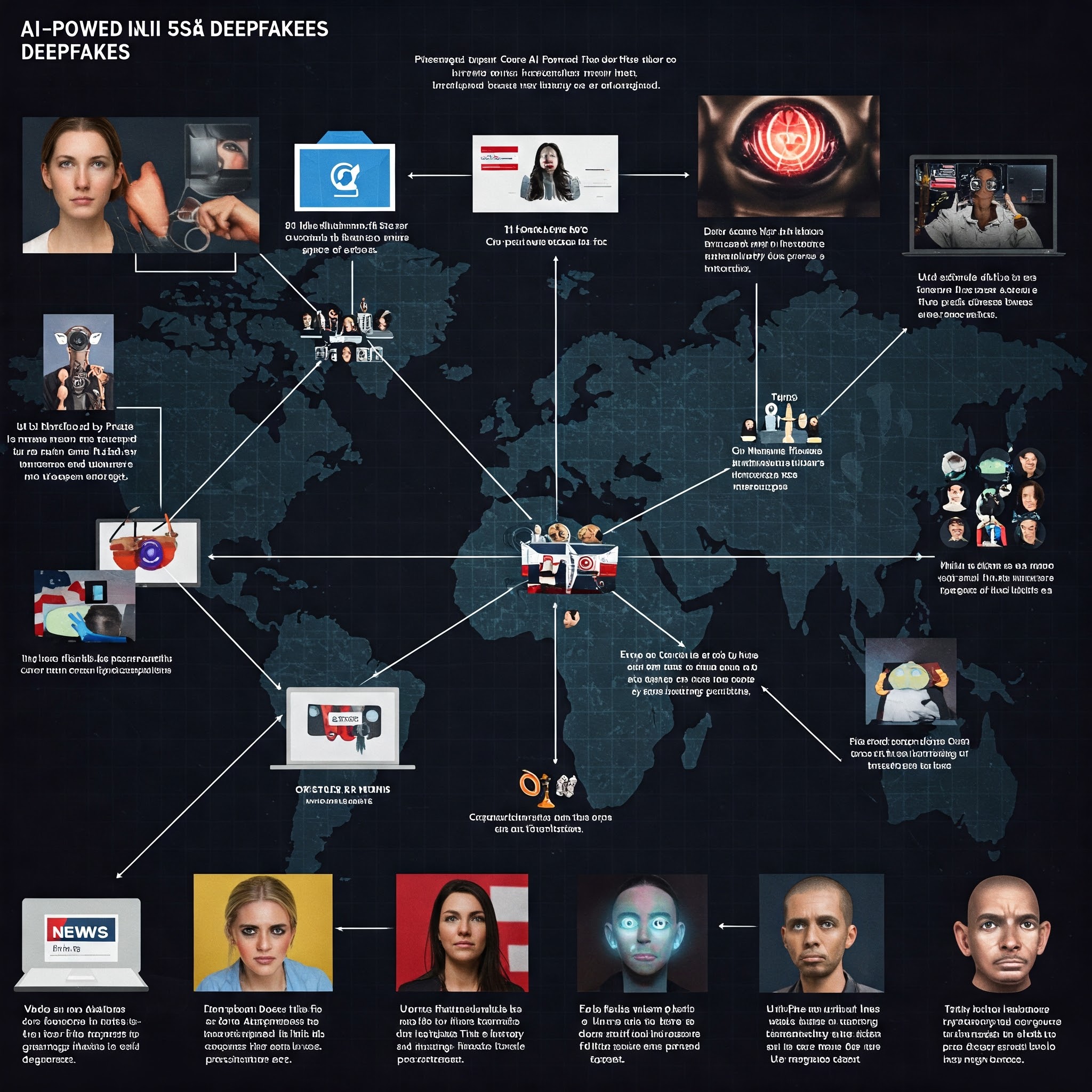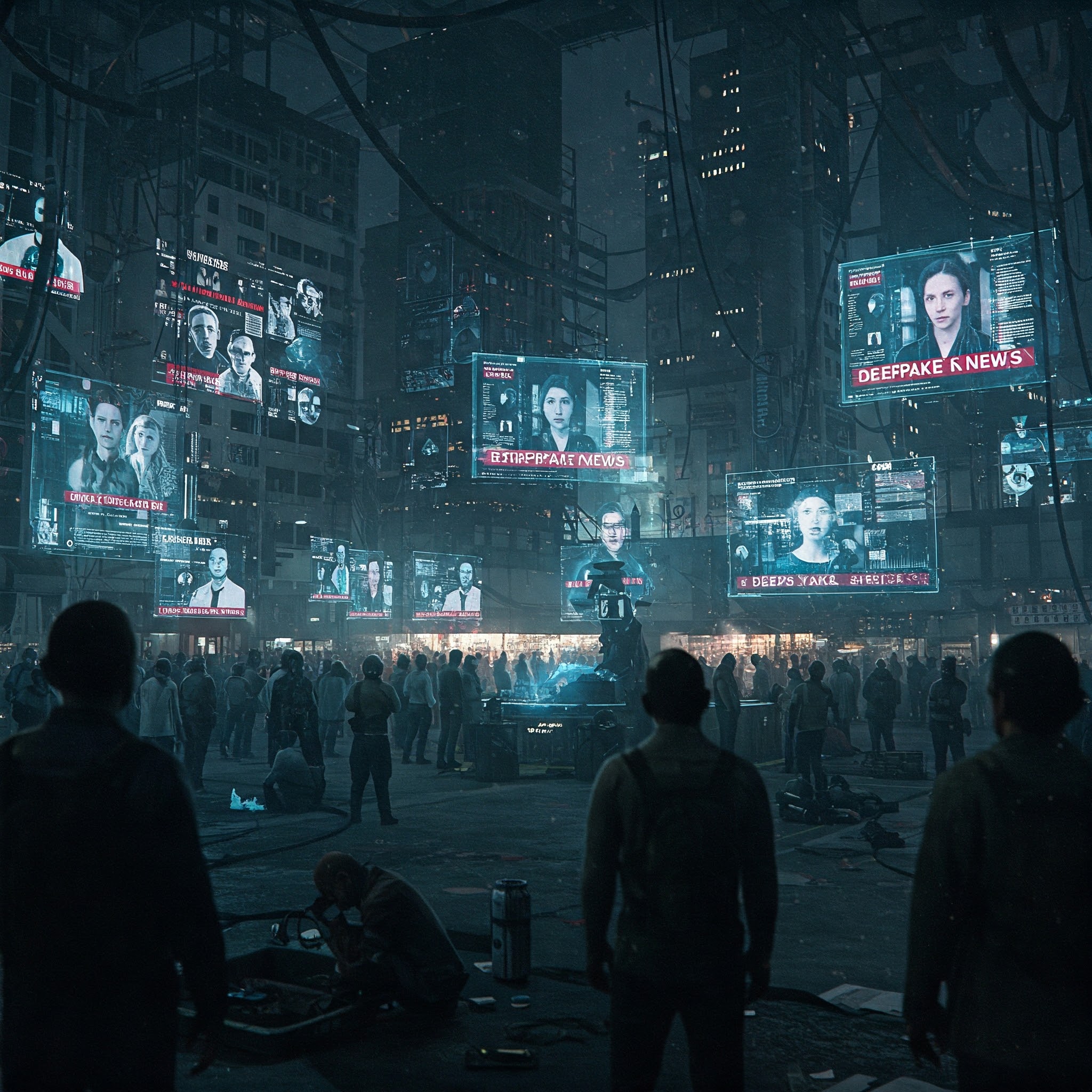
AI-Powered Misinformation & Deepfakes: Threats to Democracy
Artificial Intelligence (AI) has revolutionized content creation, but its misuse for generating fake news, deepfakes, and manipulated media poses severe risks to democracy, public trust, and social stability.

AI-Generated Fake News
Advanced language models (like GPT-4) can mass-produce convincing but false narratives, spreading propaganda at scale.
Bots and AI-driven social media campaigns amplify disinformation, influencing elections and public opinion.
Deepfakes & Synthetic Media
AI-generated videos, audio, and images can impersonate politicians, celebrities, or officials, creating false statements or scandals.
Example: Fake videos of leaders declaring war or spreading false policies could trigger panic or unrest.
Erosion of Trust in Media & Institutions
The rise of "liar’s dividend" – where real evidence can be dismissed as fake, allowing bad actors to evade accountability.
Undermines journalism, making it harder to distinguish truth from AI-generated fabrications.
Manipulation of Elections & Democracy
Foreign and domestic actors can use AI to spread targeted disinformation, suppress voter turnout, or incite division.
Deepfake endorsements or smear campaigns could swing elections.
Mitigation Strategies:
✅ Detection – Tools AI-powered deepfake detectors and forensic analysis to identify synthetic media.
✅ Regulation & Accountability – Laws requiring disclosure of AI-generated content (e.g., EU’s AI Act, U.S. proposals).
✅ Media Literacy – Public education to recognize manipulated content and verify sources.
✅ Platform Responsibility – Social media companies must label AI content and curb viral disinformation.

Here are some real-world cases of AI-powered misinformation and deepfakes, along with countermeasures being developed to combat them:
Notable Cases of AI Misinformation & Deepfakes
1. Political Deepfakes Manipulating Elections
Ukraine’s "Zelensky Surrender" Deepfake (2022)
A fabricated video of President Volodymyr Zelensky falsely telling Ukrainian troops to lay down arms was briefly circulated on hacked news websites.
Impact: Quick debunking prevented panic, but it showed how deepfakes could escalate conflicts.
Countermeasure: Ukraine’s government used social media alerts and digital forensics to expose the fake.
Slovakian Election Deepfake Audio (2023)
Two days before elections, a fake audio clip (likely AI-generated) depicted a liberal candidate discussing vote rigging.
Impact: May have swayed close election results in favor of a pro-Russia party.
2. AI-Generated Fake News Websites
"NewsGuard" Report on AI Fake News Farms (2023)
Over 400 AI-generated news sites were discovered, producing propaganda in multiple languages with fake author profiles.
Example: A site impersonating Miami’s local news spread false claims about Biden’s health.
Countermeasure: Fact-checking organizations track AI-generated sites, and browsers like Google now downgrade them in search results.
3. Celebrity & Financial Scams Using Deepfakes
AI Scam Calls Mimicking Loved Ones (2023)
Criminals cloned voices of family members in distress to extort money (e.g., "I’ve been kidnapped, send ransom!").
Countermeasure: Banks and telecom companies now warn customers about voice-cloning scams.
Fake "Elon Musk" Crypto Promotions
Deepfake videos of Musk promoted fraudulent Bitcoin schemes on YouTube and X (Twitter), duping investors.
Countermeasure: Platforms now use AI to detect and remove impersonation scams faster.
Countermeasures Against AI Misinformation
1. Detection Technology
Microsoft’s Video Authenticator: Analyzes deepfakes by detecting subtle facial distortions.
Adobe’s Content Credentials: Tags AI-generated images with metadata (like a "nutrition label" for media).
2. Policy & Regulation
EU’s AI Act (2024): Requires watermarking AI-generated content; bans manipulative deepfakes.
U.S. Deepfake Task Force (DEEPFAKES Act): Proposes criminal penalties for malicious deepfakes.
3. Public Awareness & Media Literacy
Google’s "About This Image" Tool: Shows if a picture is AI-generated or previously fact-checked.
School Programs: Countries like Finland teach students to spot fake news via gamified learning.
4. Platform Accountability
Meta’s AI Labels: Facebook/Instagram now flag AI-generated posts.
Twitter/X Community Notes: Crowdsourced fact-checking counters viral lies.
The Road Ahead
While AI threats are evolving, so are defenses. Future solutions may include:
Blockchain for Media Verification (e.g., tracking origin of videos).
AI "Immunity" Tools – Apps that alert users to deepfakes in real-time.

Conclusion
While AI offers immense benefits, its misuse threatens the foundation of democratic societies. Combating AI-powered misinformation requires technology, policy, and public awareness to safeguard truth and trust in the digital age.
Powered by Froala Editor

Parenting
Dependence on AI & Loss of Human Skills
Artificial Intelligence (AI)
AI in Cybersecurity: Hacking & Cybercrime
Artificial Intelligence (AI)
Existential Risk & Superintelligent AI
Artificial Intelligence (AI)
AI Manipulation & Behavioral Control